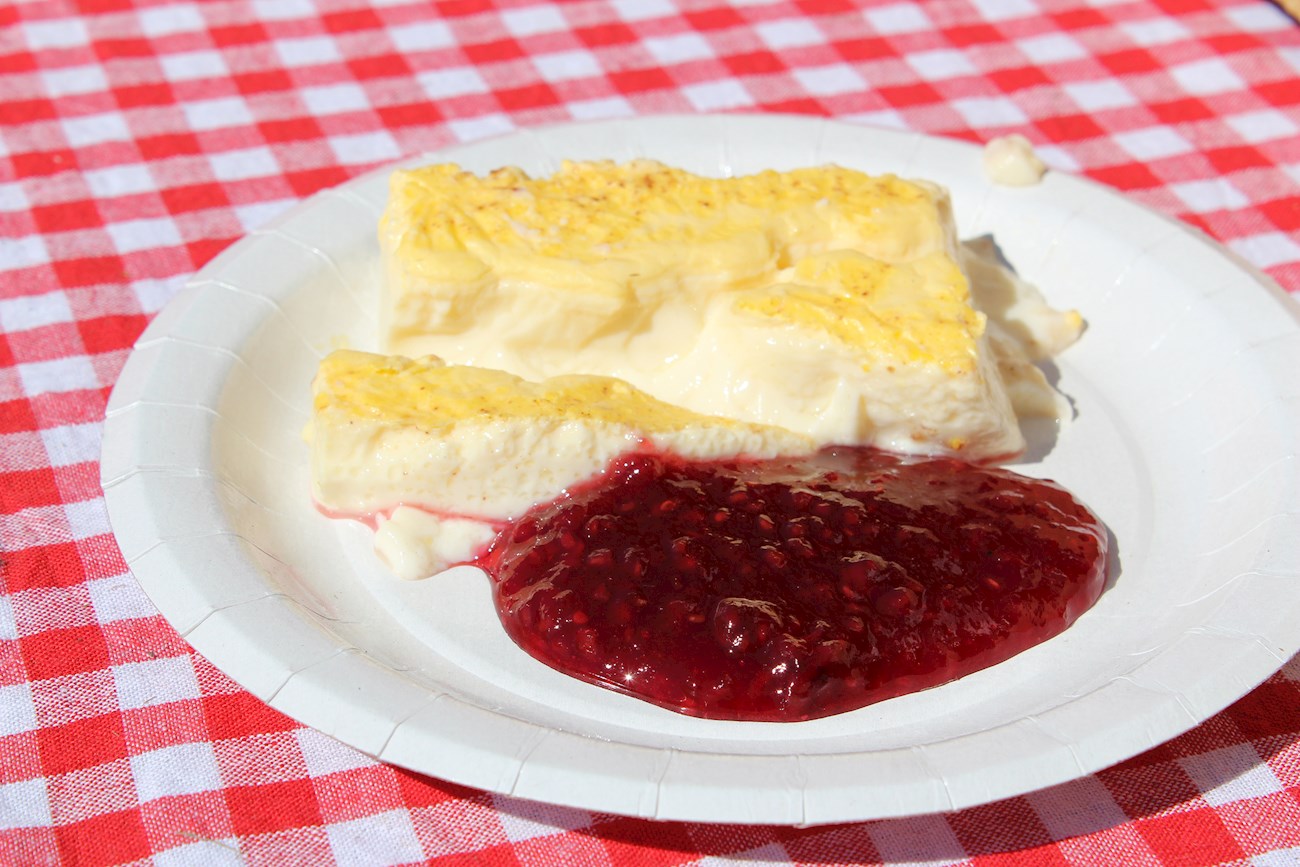Møsbrømlefse is a traditional sweet snack originating from Salten. It consists of a lefse flatbread that's stuffed with melted goat cheese, buttermilk, syrup, and flour. The combination is slathered on the flatbread, and it can be eaten as it is, or topped with additional ingredients such as butter, sugar, or sour cream.
In the past, møsbrømlefse was prepared for workers who needed a substantial meal to power them through in the cold. Nowadays, it's a tasty afternoon snack or an after-school treat.
This traditional Scandinavian dish is prepared with a combination of cow’s milk and beestings or colostrum – a yellow, rich milk produced by the animal right after it gave birth to a calf. The mixture is baked in the oven and the product acts as a coagulant, eventually thickening the milk to create a thick, custard-like dish.
Often compared to baked cheese, uunijuusto is traditionally enjoyed as a dessert that is often sweetened, spiced with cinnamon, and complemented by fresh berries.
Kvæfjordkake is a traditional cake originating from Kvæfjord on the island of Hinnøya. It consists of layers of cake, meringue, vanilla cream, and chopped almonds. Rich, yet light, the cake is made with a combination of butter, sugar, egg yolks, flour, baking powder, milk, and vanilla sugar.
The meringue is made with egg whites, salt, sugar, and almonds, while the vanilla custard contains sugar, egg yolks, starch, whole milk, and vanilla. Kvæfjordkake is also known as verdens beste, which means world's best cake.
Krumkake are traditional Norwegian wafer cookies. The batter is made with a combination of eggs, sugar, vanilla, flour, baking powder, cardamom, and butter. Once prepared, the batter is cooked on a special griddle that imprints the wafers with a visually attractive design.
After they've been baked, these wafer cookies are rolled, then often filled with whipped cream and dusted with powdered sugar. Krumkake are prepared and consumed throughout Scandinavia, and they're especially popular during the festive Christmas season.
MAIN INGREDIENTS
Tilslørte bondepiker is a traditional Scandinavian dessert that's popular in Norway, Sweden, Finland and Denmark. It's made with three simple ingredients that are staples of most Norwegian kitchens – breadcrumbs (often mixed with cinnamon), whipped cream, and apples (or other fruit such as plums).
The mashed fruit is placed on the bottom of this layered dessert, followed by whipped cream, toasted breadcrumbs, then another layer of whipped cream and breadcrumbs. If desired, the dessert can be garnished with almonds or chocolate on top, and it's usually served in a glass bowl.
Multekrem is a traditional dessert. Creamy and fluffy, it's made with a combination of whipped cream, cloudberries, and sugar. The dessert is especially popular during the Christmas season, when it can be found on most Norwegian tables. The cloudberries can be fresh or in the form of cloudberry jam.
Multekrem is traditionally served with thin waffle cookies called krumkake, or kransekake, a type of wreath cake.
Havrekjeks are traditional Norwegian oatcakes. The cookies are usually made with a combination of oats, flour, butter, milk, salt, sugar, and baker's ammonia. The butter is creamed with sugar, while the oats are mixed with flour, salt, and baker's ammonia.
Both are mixed with milk in order to make a sticky dough. The dough is rolled out and rounds are then cut out with a cookie cutter. The cookies are baked until they become brown on the edges, and they're then ready to be enjoyed. It's recommended to serve havrekjeks with geitost, a soft and sweet goat's milk cheese.
Tropisk aroma-kake is a classic cake originating from Norway. The flavor of nutmeg in the cake and coffee in the icing give this cake an exotic aroma and its name. The cake is usually made with a combination of flour, baking powder, eggs, sugar, butter, salt, nutmeg, milk, and cinnamon, while the icing is made with a combination of coffee, vanilla, butter, cocoa powder, and icing sugar.
The batter is placed into a baking pan and baked for about 20 minutes. It is then left to cool on a wire rack and topped with the icing, which also goes on the sides of the cake in thin layers. Once prepared, tropisk aroma-kake is typically sliced in thin wedges when served.
MAIN INGREDIENTS
Kransekake is a traditional Nordic dessert consisting of a number of concentric cake rings which are usually shaped into a large cone or a tower. The crispy cakes are made with almond flour, sugar, and egg whites, and are held together with a white icing glaze.
Even though little is known about the origin of this luxurious cake, it is usually associated with various festive occasions in Norway, Denmark, Sweden, and Finland. Depending on the event, the cake might come in different sizes, and the center is often filled with candies, chocolates, and even champagne or wine bottles.
The fragrant fyrstekake is a classic Norwegian tart made with a thick layer of dense, cardamom-scented almond paste sandwiched between a rich, buttery dough. Also known as Royal cake or Prince’s cake, this is by far one of the most popular Scandinavian desserts, and although the recipe calls only for a handful of ingredients, the results are often said to be quite decadent and even regal in their simplicity.
Fyrstekake is traditionally prepared during the holiday season, and it is recommended to pair it with a cup of tea.
TasteAtlas food rankings are based on the ratings of the TasteAtlas audience, with a series of mechanisms that recognize real users and that ignore bot, nationalist or local patriotic ratings, and give additional value to the ratings of users that the system recognizes as knowledgeable. TasteAtlas Rankings should not be seen as the final global conclusion about food. Their purpose is to promote excellent local foods, instill pride in traditional dishes, and arouse curiosity about dishes you haven’t tried.






















